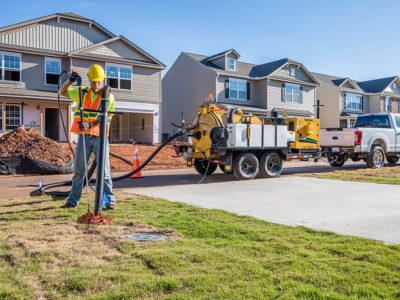Emerging municipal uses keep the vacuum excavator in constant motion, making it a valuable addition to the fleet. These versatile tools excel in applications that range from digging around utilities to efficiently excavating small holes, cleaning up catch basins, assisting with water main breaks and much more. The vacuum excavator can be used to replace more labor-intensive and inefficient methods of working.
Vacuum excavators started as support machines for horizontal drilling operations, locating existing buried utilities prior to drilling and managing the drilling slurry. This role continues to gain prominence as fiber optic networks expand and municipalities vie for the business.
“A lot of cities have applied for grants to build their own telecom networks,” said Nick Frappier, hydro-vac specialist for RDO Equipment Oregon, a Vermeer dealer. “So we’ve seen quite a few municipalities buying their own horizontal directional drills (HDDs) and vacuum excavators so they can perform their own fiber install networks.” Municipalities that sub out the installation are purchasing vacuum excavators to maintain the network once it’s been installed or to facilitate curb-to-home installation.
Soft digging helps protect sensitive environments
The soft digging process of vacuum excavators combines suction and high-pressure water or air to remove soil from the ground. This helps protect existing infrastructure and makes the vacuum excavator ideal for many applications beyond potholing and removing drilling slurry.
Vacuum excavators are becoming the preferred method to excavate in many applications where existing infrastructure exists. Excavating footings for poles, signs and fence posts has become common. In northern climates, it makes it less challenging to dig below the frost line.
One task that is often a challenge for municipalities is digging up and replacing existing utility poles that have either been damaged or exceeded their useful life. Using an excavator or backhoe to dig up the poles without disrupting surrounding utilities can present a difficult challenge. The vacuum excavator is well suited to this task. It can dig around the pole, even when buried utility lines are tied into the pole.
Vacuum excavation excels in digging tasks where either a small hole is required or there may be hidden infrastructure. Holes can be dug for new trees and stumps can be removed around existing utilities. Vacuum excavation can also access tight spaces. It allows municipalities to dig short runs where a backhoe may struggle with access. Vacuum excavation also proves useful for removing roots and debris around water meters and valves.
Vacuums clean up
Many of the applications for vacuum excavators don’t even involve digging. The vacuum technology can be used in cleanup operations and aide in waterline repair. Air vacuum excavators are also a good choice for pressure testing sewer lines.
Street departments often use vacuum excavators to clean out intakes. Gravel and dirt can be sucked out of storm catch basins, and waste can be removed from storm drains and culverts. “A large municipality may buy a Vermeer HTV hydro vacuum excavation truck just for doing catch basic clean outs,” said Sean Montgomery, hydro-vac specialist for RDO Equipment California.
Water line repairs are another common use. When water mains break and the pump can’t keep up, vacuum excavators can handle the job. They also prove useful to exercise water valves and jet sewer pipes when properly equipped. Vermeer offers valve exercisers on trailer vacs. “We’re seeing more use of that feature,” said Frappier. “Municipalities buy a lot of our small 150-g (567.6-L) units to do their own meter replacements, change their own valves and clean out their own valve cans. It’s an all-in-one unit for them.”
A jetter unit option can further add to the versatility. High-pressure water streams through specialized jetting nozzles to dislodge and clear obstructions, as well as perform regular maintenance to help prevent sewage backups. “Most municipalities are running jetter combo trucks because they want to be able to use the truck for multiple applications,” Montgomery said.
In addition to jetters and valve exercisers, there are other configurations that can expand the use of vacuum excavation technology. The Vermeer XR2 vacuum excavator is the industry’s first vacuum excavator equipped with a shaker deck that separates liquids and solids to allow crews to stay on the jobsite longer, work efficiently and help minimize disposal expenses. The design of the XR2 can help expand the use of vacuum excavation to stitch boring, slot trenching and general construction.
Contact your local Vermeer dealer for more information on vacuum excavators.
Vermeer MV Solutions, Inc. reserves the right to make changes in engineering, design and specifications; add improvements; or discontinue manufacturing or distribution at any time without notice or obligation. Equipment shown is for illustrative purposes only and may display optional accessories or components specific to their global region. Please contact your local Vermeer dealer for more information on machine specifications.
Vermeer and the Vermeer logo are trademarks of Vermeer Manufacturing Company in the U.S. and/or other countries. © 2022 Vermeer Corporation. All Rights Reserved.
